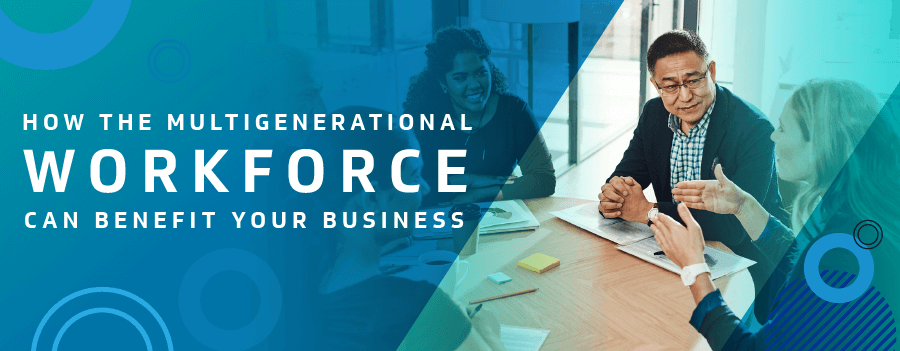
PUBLISHED JANUARY 18, 2022
How Age Diversity is Shaping Today's Workforce
They say age is just a number, but in today’s workforce, it’s so much more. With five generations in the mix, modern workplaces are filled with a melting pot of knowledge, attitudes, ideas and personal and professional experiences.
What does age distribution look like in today’s workforce?
Our current workforce is the most diversely aged workforce in history, comprised of:
- The Silent Generation (1928-1945)
- Baby Boomers (1946-1964)
- Generation X (1965-1980)
- Millennials (1981-1996)
- Generation Z (1997-2012)
While much of the recent conversation around age in the workplace focuses on the influx of young people, there are also high numbers of older generations remaining in or rejoining the workforce. According to the Bureau of Labor Statistics, employment of workers aged 65 or older has grown by 117% in the past 20 years. They also predict that in 2022, 1 in 4 workers will be 55 or older. As a result, the age composition of our workforce will continue to diversify.
Why is age diversity an advantage in the workplace?
While different generations are made up of incredibly unique, diverse individuals who cannot be wholly characterized by one specific set of traits, there are certain valuable strengths and contributions we can observe from each. As Forbes notes, having a diversely aged workforce increases intellectual and social capital as well as diversity of thought, all of which support improved organizational performance. Forbes also cites a 2020 Journal of Applied Psychology study which found that working among age-diverse teams improved motivation and retention among both younger and older employees. An organization that is comprised of individuals with diverse experiences and skills has a competitive advantage in today’s working world, so supporting an intergenerational workforce should be a high priority of any organization’s DE&I strategy.
How to target each generation’s strengths in the workplace
Here’s what we can learn about each generation’s strengths and how to utilize them to foster a dynamic and inclusive work environment.
The Silent Generation
The Silent Generation is currently the oldest generation in the workforce, aged mid 70s-early 80s. While individuals in this generation are past the average retirement age, many remain employed or contribute as partners, board members or advisors. It was given its name by a 1951 Time Magazine article that characterized this group as less adventurous and more risk-averse than its predecessors due to growing up during turbulent periods like the Great Depression and World War II. Silent Generation individuals have a traditional mindset and value a strong work ethic. They also value security and stability, and therefore are more likely than other generations to stay employed with the same organization for most, if not all, of their careers.
Areas of Strength: With years of experience, members of the Silent Generation are a wealth of industry knowledge. Due to the value they place on work ethic, they are also determined, focused contributors who persevere through workplace challenges. You can rely on them to provide industry expertise, possess well-honed baseline skills and be self-reliant, high-producing contributors.
Baby Boomers
As the last generation to start their careers before the introduction of modern technology, Baby Boomers share a more traditional perspective with the Silent Generation. While those still in the workforce have adapted well to the use of digital communication, they still prefer face-to-face interactions. They are also team-oriented and place great value on career success and contributions; as 2021 SHRM article notes, they value loyalty and “going the extra mile” for one’s team.
Areas of Strength: Like their predecessors in the Silent Generation, Baby Boomers are a valuable source of industry knowledge. They also excel at direct communication and can be particularly effective in leadership positions as well as areas of mentorship, training and continuous education.
Generation X
Generation X was the first generation to experience the advent of the digital age early in their careers, having a front-row seat to the birth of the Internet, desktop computers, cell phones and social media. As a result, they have the unique position of being an older, more traditionally experienced generation that is also proficient in modern technology, with Nielson reporting that 54% of Gen X individuals consider themselves digitally savvy. They’re typically characterized as a more progressive generation than their predecessors, making them more likely to depart from the workforce norms and processes put in place by previous generations.
Areas of Strength: Generation X employees tend to be resourceful, resilient, adaptable and strong problem-solvers. They often excel when contributing to strategic or operational initiatives and do well in leadership roles.
Millennials
Millennials are the most dominant generation in the workforce and are on track to make up 75 percent of the workforce by 2025, according to Pew Research Center. While the age range of millennials currently stretches from late 20s to early 40s, they remain one of the most frequent subjects of discourse about younger generations in the workforce. A digitally engaged, highly motivated generation, millennials are known for breaking away from professional norms set by previous generations to encourage a more change-driven, flexible and dynamic work environment.
Areas of Strength: Millennials are multitaskers and efficient communicators, with a preference for texting, email and other short-form communication channels. They are also more highly educated than their predecessors, with about 40% of those ages 25 to 37 holding a bachelor’s degree or higher, compared with 15% of the Silent Generation, 25% of Baby Boomers and 29% of Gen Xers when they were the same age. Utilize these strengths by placing millennials on fast-paced, highly involved initiatives.
Generation Z
Generation Z, the youngest generation in the workforce, is known as the first digital generation, growing up alongside the rise of technology like smartphones, streaming services and social media. As a result, Gen Z are highly tech-savvy and digitally literate. This generation is also known for being incredibly diverse (nearly half are racial or ethnic minorities) and are more likely to have high standards for social justice, DE&I strategy and corporate social responsibility in the workplace.
Areas of Strength: Gen Z possess a high level of emotional intelligence, have the potential to be key drivers of change management and can provide valuable contributions to conversations about workforce development and evolving practices. They are also career growth-oriented; a Kforce survey found that nearly 61% of those who identified as Gen Z said opportunities for career growth was the most important factor when considering a job offer. You can harness this passion for advancement by offering opportunities for training and continuous learning, growing the overall skill level of your organization while helping Gen Z employees carve their desired paths for career progression.
Learn more: This is My Kforce: Casey Birdsall
Each generation brings its own strengths to the workforce. Taking advantage of intergenerational teams will put your organization in a strong competitive advantage in today’s fast-evolving working world.
Learn more: Fostering Diversity, Equity and Inclusion in the Workforce

